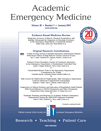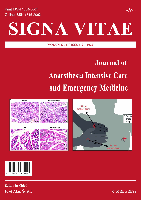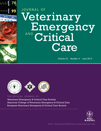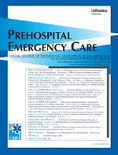
Notarzt
Scope & Guideline
Advancing critical care knowledge for a healthier tomorrow.
Introduction
Aims and Scopes
- Prehospital Emergency Medicine:
This includes research on emergency medical services (EMS) protocols, interventions, and the efficacy of treatments administered in prehospital settings. - Innovations in Emergency Care:
The journal frequently publishes studies on new technologies, such as telemedicine and ultrasound applications, that enhance patient care in emergency situations. - Clinical Guidelines and Protocol Development:
A significant focus is on the development and dissemination of clinical guidelines that inform best practices for emergency medical professionals. - Pharmacological Interventions in Emergencies:
Research related to the administration of medications, including analgesics and anesthetics, in emergency settings is a core area of investigation. - Training and Education in Emergency Services:
The journal emphasizes the importance of training for emergency medical personnel, reflecting on educational practices and the impact of training on emergency care outcomes. - Legal and Ethical Issues in Emergency Medicine:
Discussions around the legal frameworks and ethical considerations impacting emergency medical practice are regularly addressed.
Trending and Emerging
- Telemedicine and Remote Emergency Care:
The integration of telemedicine in emergency care is rapidly gaining focus, as evidenced by multiple recent studies exploring its effectiveness and implementation in prehospital settings. - Advanced Pharmacological Management:
There is an increasing emphasis on advanced pharmacological interventions, including the use of novel analgesics and anesthetics, indicating a trend towards optimizing pain management in emergency situations. - Data-Driven Decision Making in Emergency Services:
The use of data analytics to improve decision-making processes in emergency medical services is emerging, with studies exploring the impact of data collection and analysis on patient outcomes. - Interdisciplinary Collaboration in Emergency Medicine:
Research highlighting the importance of interdisciplinary approaches and collaboration among various healthcare professionals in emergency settings is on the rise. - Mental Health and Psychosocial Aspects of Emergency Care:
There is a growing body of literature addressing the mental health implications for both patients and emergency personnel, reflecting an increased awareness of psychosocial factors in emergency medicine.
Declining or Waning
- Traditional Emergency Response Protocols:
There is a noticeable reduction in publications focused on traditional emergency response protocols, possibly as the field shifts towards more integrated and technology-driven approaches. - Basic Life Support Techniques:
Research centered on basic life support techniques seems to be less frequent, indicating a potential shift towards advanced care practices and comprehensive resuscitation strategies. - Historical Perspectives on Emergency Care:
Papers that explore historical perspectives or retrospective studies on emergency care practices are appearing less often, suggesting a move towards current and future-oriented research. - Regional Studies with Limited Applicability:
Studies that focus on specific regional practices without broader applicability are declining, as there is a growing emphasis on research that can inform best practices across diverse settings. - Single-Centered Case Reports:
The publication of single-centered case reports is diminishing, possibly in favor of larger scale studies or systematic reviews that provide more generalizable findings.
Similar Journals

Prehospital and Disaster Medicine
Pioneering Research in Prehospital CarePrehospital and Disaster Medicine is a leading peer-reviewed journal published by Cambridge University Press that targets the ever-evolving fields of emergency medicine and disaster management. With an ISSN of 1049-023X and an E-ISSN of 1945-1938, this journal has established its significance within the academic community since its inception, with coverage extending from 1985 to the present. It is widely recognized within its category as evidenced by its 2023 rankings, which position it in the Q2 quartile for both Emergency Medicine and Emergency Nursing. The journal boasts impressive Scopus rankings, standing at Rank #7/32 in Emergency Nursing and Rank #31/109 in Emergency Medicine, demonstrating its relevance and impact in these critical areas. Although it does not offer Open Access, Prehospital and Disaster Medicine is committed to disseminating vital research and innovative practices that address prehospital care, disaster response, and the intersection of these fields, serving as an essential resource for researchers, professionals, and students alike.

Open Access Emergency Medicine
Connecting researchers to the forefront of emergency healthcare.Open Access Emergency Medicine, published by DOVE MEDICAL PRESS LTD, is a premier journal dedicated to the dynamic fields of Emergency Medicine and Emergency Nursing. With its ISSN 1179-1500, this journal has established a notable presence since its inception as an Open Access platform in 2010, offering unrestricted access to high-quality research and innovative practices in the area. As one of the leading journals in its field, it holds a respectable Q2 ranking in both Emergency Medicine and Emergency Nursing categories as of 2023, reflecting its commitment to advancing knowledge and fostering impactful research. The journal is indexed in prestigious databases with solid Scopus rankings, placing it in the 65th percentile for Emergency Medicine and the 64th percentile for Emergency Nursing, ensuring that contributions reach a diverse audience of researchers, practitioners, and students worldwide. With its focus on contemporary issues, this journal serves as an essential resource for the continual growth and development of emergency health services.

Emergencias
Advancing Emergency Care Through Innovative ResearchEmergencias is a prestigious journal in the field of Emergency Medicine, published by the Sociedad Española de Medicina de Urgencias y Emergencias (SEMES). This journal has established itself as a vital platform for sharing cutting-edge research and practical insights, ranking in the top 20 of emergency medicine journals according to Scopus, with a commendable 82nd percentile performance. Since its inception, it has maintained a commitment to advancing knowledge and practice in emergency care, making contributions essential for both researchers and practitioners. The journal features diverse articles covering clinical guidelines, innovative techniques, and case studies, reflective of its importance in guiding timely medical interventions. As an open access publication, it encourages widespread dissemination of knowledge, fostering collaboration and understanding across the global emergency medicine community. Emergencias continues to publish high-quality research until 2024, making significant strides in enhancing emergency healthcare practices in Spain and beyond.

ACADEMIC EMERGENCY MEDICINE
Elevating Research in Critical CareACADEMIC EMERGENCY MEDICINE, published by Wiley, stands as a leading journal in the field of emergency medicine, distinguished by its impressive rankings, including Q1 categories in both Emergency Medicine and Miscellaneous Medicine. With an ISSN of 1069-6563 and an E-ISSN of 1553-2712, the journal covers a broad array of topics relevant to emergency medicine, advancing research from its inception in 1994 up to 2024. Ranked #8 out of 109 in its category, this journal sits in the 93rd percentile according to Scopus, underscoring its significance and influence within the academic community. Although it does not currently offer open access options, its rigorous peer-review process and comprehensive publication standards ensure that only the highest quality research reaches its readership. Aimed primarily at researchers, practitioners, and students in the field, ACADEMIC EMERGENCY MEDICINE serves as an essential resource for those seeking to enhance their understanding and practice of emergency care, making significant contributions to both theory and clinical applications in the field.

Hong Kong Journal of Emergency Medicine
Your Gateway to Cutting-edge Emergency ResearchThe Hong Kong Journal of Emergency Medicine, published by WILEY, stands as a vital resource in the field of Emergency Medicine since its inception in 2004. With a commitment to advancing clinical practice and research, this open access journal—transitioned to open access in 2018—facilitates the dissemination of crucial knowledge among healthcare professionals and researchers, fostering a collaborative environment for addressing urgent medical challenges. The journal boasts an impressive impact factor and holds a Q2 ranking in the Emergency Medicine category for 2023, reflecting its significance and influence within the academic community. Located in Hong Kong, this journal aims to explore a broad spectrum of topics related to emergency and critical care, making it an essential publication for those seeking to enhance their understanding and practice in this fast-evolving field. Accessible through ISSN: 1024-9079 and E-ISSN: 2309-5407, it promises to be an invaluable asset for researchers, practitioners, and students alike.

Signa Vitae
Advancing knowledge in critical care and emergency medicine.Signa Vitae is a distinguished academic journal published by MRE PRESS, focusing on critical care, intensive care medicine, and emergency medicine. Established in 2008 and running through 2024, this journal serves as an essential conduit for the dissemination of innovative research and clinical practices in these dynamic fields. Based in Croatia, Signa Vitae is indexed in Scopus, highlighting its importance within the scholarly community, boasting respectable quartiles with a Q3 ranking in both Critical Care and Intensive Care Medicine and Emergency Medicine as of 2023. Although it operates under a traditional access model, the journal aims to enhance knowledge sharing and interdisciplinary dialogue among researchers, healthcare professionals, and students globally, addressing the urgent challenges and advancements in patient care. By providing a platform for high-quality studies and reviews, Signa Vitae continues to advance the conversation and practice within critical and emergency medicine.

Clinical and Experimental Emergency Medicine
Elevating emergency medicine with cutting-edge insights.Clinical and Experimental Emergency Medicine, published by the SEOUL KOREAN SOCIETY OF EMERGENCY MEDICINE, is a premier Open Access journal dedicated to advancing knowledge and practice within the fields of emergency medicine and emergency nursing. With an ISSN of 2383-4625 and an E-ISSN of 2383-4625, this journal has established itself prominently in the academic community, achieving a notable Q2 ranking in both Emergency Medicine and Emergency Nursing categories in 2023. The journal is committed to providing highly relevant research, innovative clinical practices, and educational resources that address the urgent and evolving challenges in emergency care. With a vision to foster collaboration among researchers, practitioners, and students, it aims to contribute significantly to the body of knowledge that enhances emergency medical services and improves patient outcomes globally. Accepting submissions and offering Open Access since its inception in 2014, the journal is positioned as a key resource for those dedicated to the advancement of emergency medicine.

JOURNAL OF VETERINARY EMERGENCY AND CRITICAL CARE
Advancing veterinary care in critical moments.JOURNAL OF VETERINARY EMERGENCY AND CRITICAL CARE, published by WILEY, is a leading journal in the field of veterinary science, specifically focusing on emergency medicine and critical care for animals. With an impact factor that underscores its significance in the field, this journal serves as a crucial resource for veterinary professionals, researchers, and students dedicated to advancing the care of animals in critical conditions. Since its inception in 1991, the journal has continually contributed to the knowledge base and methodological advancements in veterinary emergency practices, consistently ranking in the Q1 category for veterinary sciences, as per the latest Scopus Ranks. Located in the United Kingdom, the journal is committed to disseminating high-quality, peer-reviewed research that addresses the challenges and innovations in veterinary critical care. With its goal to enhance clinical outcomes through evidence-based practices, the JOURNAL OF VETERINARY EMERGENCY AND CRITICAL CARE remains an essential platform for scholarly communication and collaboration in veterinary medicine.

African Journal of Emergency Medicine
Pioneering Research for Africa's Emergency HealthcareAfrican Journal of Emergency Medicine, published by ELSEVIER, serves as a pivotal platform for disseminating innovative research and advancements in emergency medicine and critical care nursing. Launched in 2011, this Open Access journal has quickly garnered attention for its commitment to enhancing healthcare delivery across Africa, catering to a diverse audience of researchers, practitioners, and students. With an impressive rank of #44/109 in Emergency Medicine and positioning itself in the Q2 category for Critical Care Nursing and Emergency Nursing in 2023, the journal has established itself as a significant contributor to the medical community. The journal encourages the submission of high-quality research, reviews, and case reports that can inform clinical practices and emergency protocols across the continent. Its accessibility, reflected by its open access model, ensures that vital findings are available to those who need it most, thus fostering greater collaboration and innovation in emergency healthcare. With a focus on improving patient outcomes and advancing the field, the African Journal of Emergency Medicine is an essential resource for all who are committed to emergency care and related disciplines.

Prehospital Emergency Care
Delivering Excellence in Emergency Medicine and Nursing.Prehospital Emergency Care is a leading journal in the fields of emergency medicine and nursing, published by Taylor & Francis Inc. With a significant impact on both disciplines and recognized in the first quartile (Q1) of Emergency Medicine and Emergency Nursing categories for 2023, this journal reflects the highest standards of scientific rigor and innovation. Each issue offers valuable insights into the latest research, clinical practices, and advancements in prehospital emergency care, making it an essential resource for researchers, healthcare professionals, and students alike. The journal covers a broad array of topics and aims to disseminate knowledge that enhances the field and improves patient outcomes. With its commitment to excellence, Prehospital Emergency Care plays a critical role in shaping the future of emergency services globally.